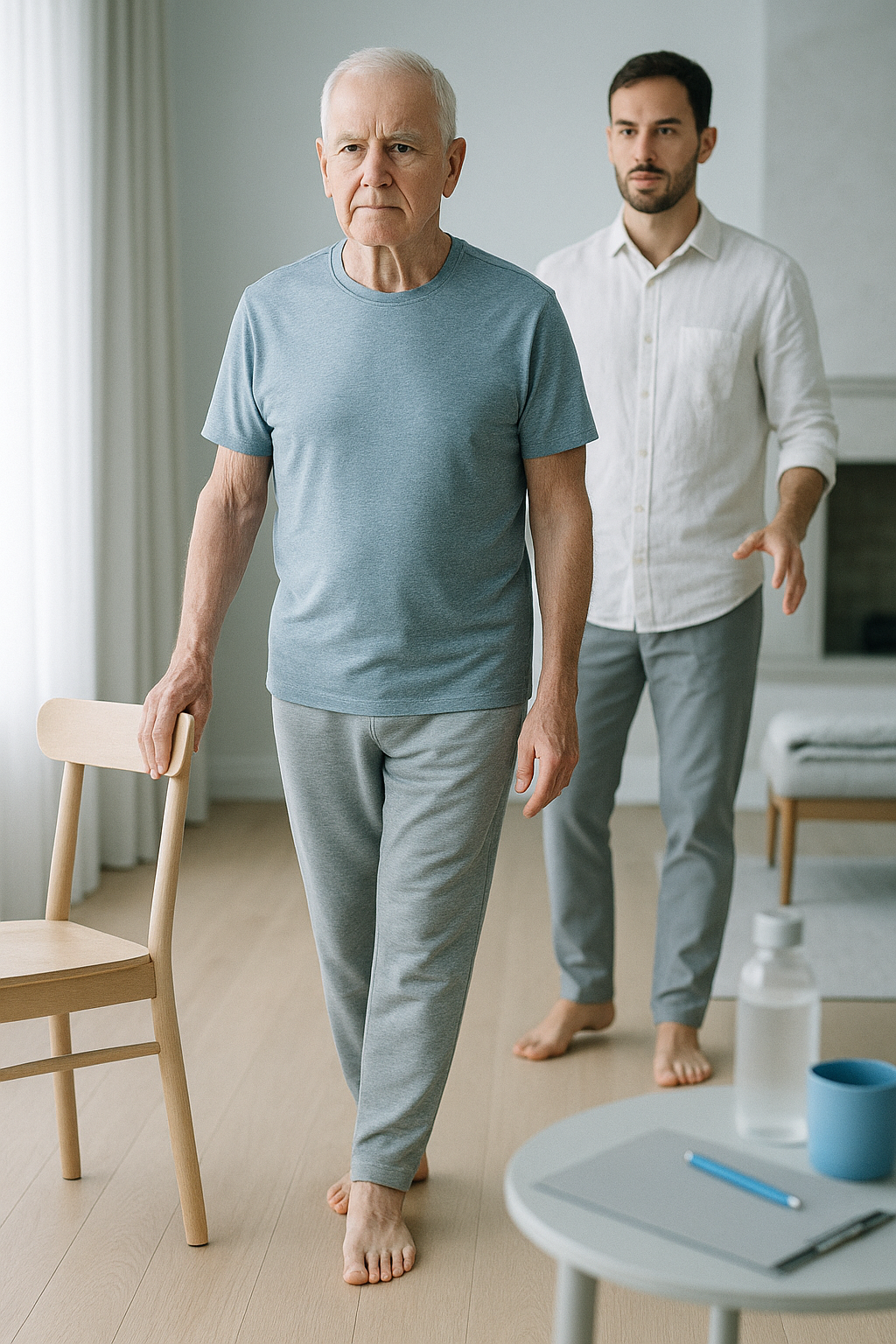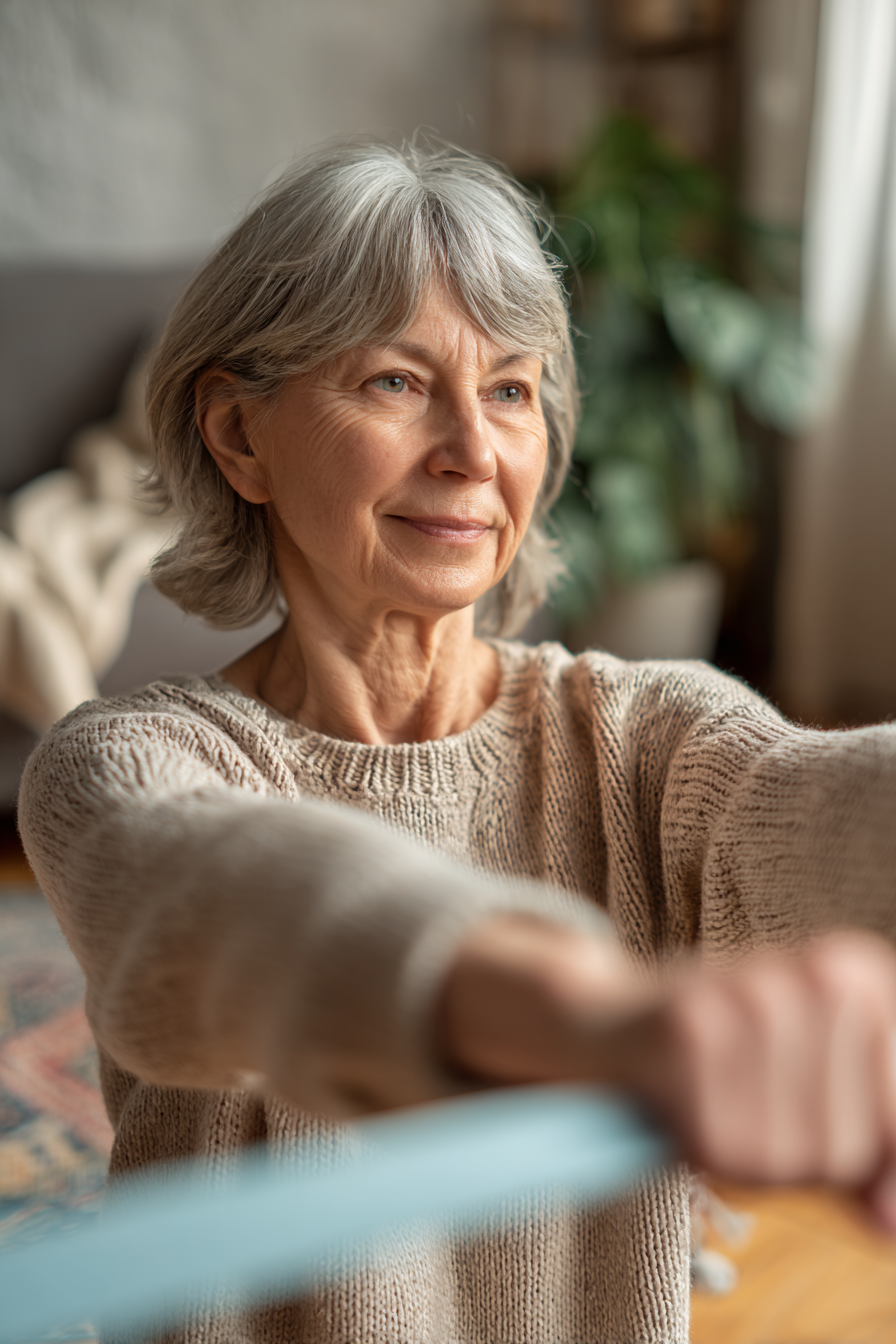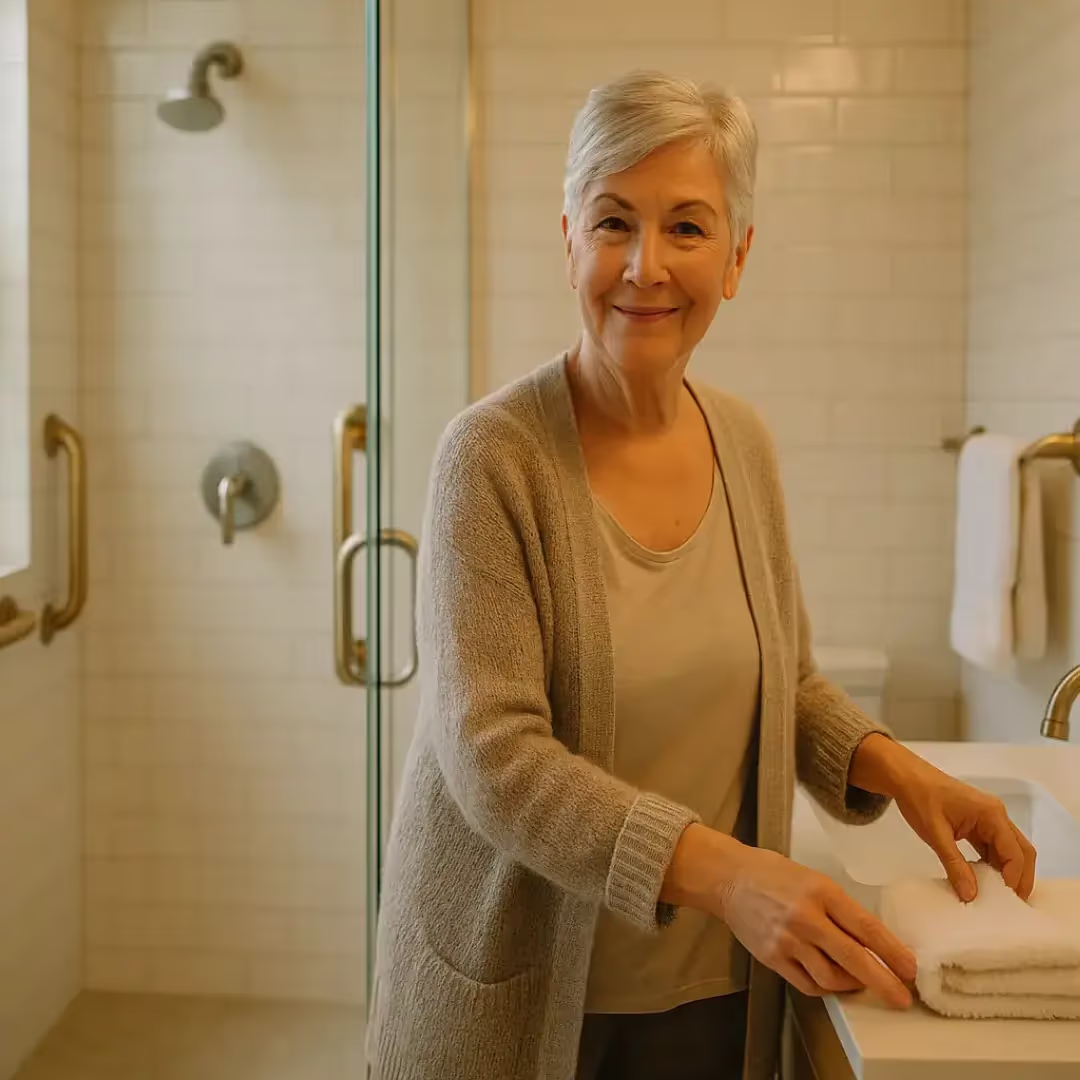
Share
Estimated reading time: 17 minutes
Living with arthritis doesn't mean giving up movement. Gentle exercises for arthritis pain are low-impact, controlled movements designed to reduce joint stress while improving flexibility, strength, and circulation. These activities prioritise range of motion, muscle support around vulnerable joints, and pain-limited intensity—meaning you work within a comfortable range rather than pushing through sharp discomfort. For Canadian seniors, understanding how to move safely can mean the difference between worsening stiffness and regaining independence in daily tasks.
Why do gentle exercises help? Movement stimulates production of synovial fluid, the natural lubricant inside your joints. Regular activity reduces the inflammatory stiffness that builds up after sitting or sleeping, supports the muscles that protect your knees, hips, and other joints, and improves overall function. Inactivity, on the other hand, often worsens pain and accelerates loss of mobility.
This article focuses on practical, accessible options for Canadian seniors. You'll find guidance on provincial resources, recommendations from Arthritis Society Canada, and examples of municipal programs across the country. We'll walk through safety checks, red flags that require a visit to your healthcare provider, and a simple four-week starter routine you can do at home, in a chair, or in a pool.
Key Takeaways
- Gentle exercises for arthritis pain use low-impact movements to improve joint lubrication, reduce stiffness, and strengthen supporting muscles.
- Consistency matters more than intensity—aim for regular, pain-limited activity rather than occasional hard workouts.
- Always complete a pre-exercise safety check and consult your healthcare provider if you have severe arthritis, recent surgery, or new symptoms.
- Walking, cycling, tai chi, stretching, resistance work, and water-based routines are all effective, accessible options for Canadian seniors.
- Track your pain, morning stiffness, and daily function over four weeks to personalise your plan and know when to adjust.
What "gentle exercises for arthritis pain" means and why they work
Gentle exercises for arthritis pain are low-impact, low-load activities that reduce stress on your joints while helping you maintain or restore movement. These exercises emphasise controlled range of motion, building muscle support around the joint, and working at an intensity guided by your pain level rather than external targets. Examples include slow walking, seated stretches, resistance-band work, and water aerobics—all designed to be joint-friendly.
Arthritis involves inflammation, cartilage wear, and stiffness, especially after periods of rest. When you move gently and regularly, your body responds by increasing synovial fluid production. This fluid acts as a cushion and lubricant inside the joint, easing friction and reducing stiffness. Strengthening the muscles around a joint—such as your quadriceps around the knee—also takes pressure off the joint itself, lowering pain and the risk of further damage.
Research supports this approach. Studies show that regular low-impact activity improves pain and function in people with hip and knee arthritis, and reduces the risk of disability over time. About 58 million adults in the United States report arthritis symptoms, with seniors especially vulnerable. In Canada, Arthritis Society Canada recommends daily, low-impact activity tailored to individual capabilities.
The practical takeaway: aim for consistency over intensity. You don't need to exercise hard to see benefits. Pain-limited progression—where you gradually increase time or repetitions only when your joints feel ready—preserves your joints, builds confidence, and helps you stay active for the long term.
Safety first: when to check with a health provider in Canada
Before starting any new exercise program, complete a pre-start safety checklist. Use the PAR-Q+ (Physical Activity Readiness Questionnaire for Everyone), a screening tool widely recommended in Canada. Review your current medications, any recent surgeries—especially joint replacements—and your cardiovascular history. If you have severe arthritis, new or worsening symptoms, or other major health conditions, consult your family doctor or a physiotherapist before beginning.
Certain red flags require immediate medical review. These include sudden joint swelling or redness, fever accompanying joint pain, a new and marked decrease in your range of motion, uncontrolled pain that doesn't ease with rest, or recent surgery on the affected joint. Don't ignore these signs—early intervention can prevent more serious complications.
If you have a hip or knee replacement, osteoporosis, or severe spinal stenosis, you may need modified exercises. A physiotherapist can design a tailored plan that respects your limitations while still building strength and mobility. Many provinces offer government-funded or low-cost physiotherapy for seniors through public health programs, so ask your doctor about local options.
Technology can add a layer of safety, especially if you exercise alone at home. Medical-alert and fall-detection systems—such as Holo Alert—provide monitoring and emergency support if you experience a fall or sudden health event. These devices are not medical advice, but they can offer peace of mind while you work on improving your strength and balance.
Best low-impact gentle exercises for arthritis pain: walking, cycling, and tai chi
Walking is one of the most accessible forms of exercise for seniors with arthritis. It improves joint mobility, strengthens your legs, and requires no special equipment. Start with 10 to 15 minutes at a comfortable pace, and gradually build toward 20 to 30 minutes as tolerated. Wear supportive footwear with good cushioning, choose even surfaces to reduce joint jarring, and consider using trekking poles for added stability. Many Canadian municipalities offer paved walking paths and indoor malls for year-round access.
Cycling—whether on a stationary bike or outdoors—provides cardiovascular benefits while minimising weight-bearing stress on your knees and hips. Recumbent bikes offer extra back support and are easier on the joints than upright models. Start with low resistance and short sessions, using the talk test as your guide: you should be able to hold a conversation while pedaling. If you can't, dial back the intensity. Aim for at least 150 minutes of moderate aerobic activity per week as you build tolerance.
Tai chi uses slow, flowing movements to enhance balance, stability, and flexibility. Major arthritis organisations, including the American College of Rheumatology, strongly recommend tai chi for both knee and hip arthritis because it reduces pain and improves function without stressing the joints. You can join a class through municipal recreation centres or follow along with instructional videos at home. Simple beginner moves—such as weight shifts, gentle arm circles, and slow stepping—are appropriate for most seniors.
When gauging intensity, use the talk test and a zero-to-ten pain scale. A minor ache during or after exercise is normal, but sharp pain or pain that gets worse is a signal to stop. Many Canadian communities run low-cost senior classes in walking groups, tai chi, and indoor cycling—check with your local recreation department or Arthritis Society Canada chapter for schedules.
Gentle stretching and range-of-motion routines for daily use
Daily range-of-motion exercises maintain or restore joint mobility, while gentle stretching reduces muscle tightness that can pull on already-sensitive joints. Focus on major joints: neck, shoulders, elbows, wrists, hips, knees, and ankles. These routines are especially helpful first thing in the morning to ease overnight stiffness, or after long periods of sitting.
Hold each static stretch for 15 to 30 seconds, and repeat two to four times per joint. Never bounce—smooth, sustained holds are safer and more effective. You can perform gentle stretching daily, and many people with arthritis find that five or more days per week works well.
Here are five practical stretches you can do at home:
- Seated knee extension: Sit in a sturdy chair with your feet flat. Slowly straighten one knee, lifting your foot until your leg is parallel to the floor. Hold for 15 seconds, then lower. Repeat two to four times per leg. This targets your quadriceps and knee joint.
- Hip march and hip flexor stretch: While seated, lift one knee toward your chest as high as is comfortable, then lower. Repeat 10 times per side. For a deeper hip flexor stretch, stand and take a small step forward into a gentle lunge, keeping your back heel on the ground.
- Ankle pumps and circles: Sit with your legs extended or resting on a footstool. Point your toes away from you, then flex them back toward your shin. Repeat 10 times. Then draw slow circles with your toes, five in each direction, to maintain ankle mobility.
- Shoulder rolls and wall slides: Roll your shoulders backward in slow circles five times, then forward five times. For wall slides, stand with your back against a wall and slowly raise both arms overhead as far as you can without pain, then lower. Repeat five to ten times.
- Gentle neck side-bends and rotations: Tilt your head slowly toward one shoulder, hold for 15 seconds, then tilt to the other side. Next, turn your head gently to look over one shoulder, hold, and repeat on the other side. Work within a pain-free range.
Incorporate micro-breaks throughout your day. A quick set of range-of-motion exercises after sitting for an hour, or before bed, can significantly reduce stiffness and keep your joints supple.
Strength and balance exercises to support joints and reduce flare-ups
Building muscle strength around your joints is one of the most effective ways to reduce arthritis pain. Stronger quadriceps, for example, take pressure off your knees; stronger shoulders and upper-back muscles support your neck and arms. Resistance training using your body weight or elastic bands also improves bone density and reduces fall risk—critical for seniors with arthritis.
Aim for two to three strength-and-balance sessions per week. Beginners should start with one to three sets of eight to 15 repetitions per exercise, using slow, controlled movements and a pain-limited range. If a movement causes sharp pain or significant swelling the next day, scale back or consult a physiotherapist.
Here are five gentle strength and balance exercises:
- Seated knee extension with resistance band: Loop a light resistance band around one ankle and the chair leg. Straighten your knee against the band's tension, hold for two seconds, then slowly lower. Start with one set of 10 reps, then progress to two or three sets as you build strength.
- Partial chair squats (sit-to-stand): Sit in a sturdy chair. Stand up slowly without using your hands if possible, then lower yourself back down with control. If this is too difficult, use your hands on the armrests for support, or raise the seat height with a cushion. Aim for two sets of eight to 12 repetitions.
- Heel raises: Stand behind a chair for balance. Rise up onto your toes, hold for two seconds, then lower slowly. This strengthens your calves and improves ankle stability. Repeat 10 to 15 times for two sets.
- Seated row with resistance band: Sit with your legs extended or bent, and loop a band around your feet. Pull the handles back toward your ribs, squeezing your shoulder blades together. Release slowly. This builds upper-back strength and supports good posture. Perform two sets of 10 to 12 reps.
- Balance drills—tandem stance and single-leg stand: For tandem stance, place one foot directly in front of the other (heel to toe) and hold for 10 to 30 seconds, using a counter for light support if needed. Progress to a supported single-leg stand, lifting one foot a few centimetres off the floor and holding for 10 seconds. These exercises are essential for fall prevention.
Many Canadian senior centres offer resistance-band classes, and some provinces subsidise group falls-prevention programs. Check with your local public health unit or municipal recreation office. If you notice joint swelling the day after strength work, reduce the intensity or number of repetitions, and consider a physiotherapy consultation to fine-tune your program.
Water-based and chair-based options for limited mobility
Water aerobics for arthritis is one of the most joint-friendly exercise options available. Buoyancy can reduce joint load by up to 90 per cent when you're submerged, making movement easier and less painful. Warm water—typically heated to 28 to 31 degrees Celsius (83 to 88 degrees Fahrenheit)—further eases stiffness and improves comfort. Typical aquatic moves include water walking, heel digs, marching in place, and seated arm exercises using the pool edge for support.
Safety tips for pool therapy: choose facilities with non-slip surfaces and easy entry points, such as steps or ramps. If balance is a concern, ask a friend or family member to accompany you, or look for instructor-led arthritis aquatic classes. Most Canadian cities have public aquatic centres with warm-water programs specifically for seniors and people with arthritis. Arthritis Society Canada maintains a directory of adaptive exercise facilities across the country.
Chair-based exercises are ideal if you have severe pain, limited balance, or are recovering from surgery or a flare-up. You can perform seated marching, seated leg lifts, seated trunk rotations, and resistance-band arm work—all from a sturdy, armless chair. These routines can be done daily, starting with five to ten minutes and gradually increasing as you build confidence and strength.
Whether you exercise in water or a chair, consider safety monitoring if you're alone at home. Medical-alert devices like Holo Alert can detect falls and connect you with emergency support, offering an extra layer of security during solo exercise sessions.
How to build a weekly plan: sample four-week starter routine
A successful exercise plan for arthritis balances consistency, variety, and gradual progression. Start with short, low-intensity sessions and combine range-of-motion work, aerobic activity, and gentle strength training. Monitor your pain and function, and progress by increasing time or repetitions—never intensity—until your joints adapt.
Week One: Perform daily range-of-motion stretches for five to ten minutes each morning. Add three short walks or chair-based cardio sessions of 10 to 15 minutes. Include two light strength sessions of 10 to 15 minutes, focusing on seated knee extensions, heel raises, and seated rows. Total weekly aerobic time: 30 to 45 minutes.
Week Two: Continue daily stretches. Increase your walks or cardio to 15 to 20 minutes, three times per week. Add one extra strength exercise—such as partial chair squats—and maintain two strength sessions. Total aerobic time: 45 to 60 minutes.
Week Three: Keep up daily range-of-motion work. Introduce one tai chi or aquatic class (or substitute a longer chair session). Progress your strength work to two sets per exercise, maintaining two to three sessions per week. Aerobic time: 60 to 75 minutes.
Week Four: Build aerobic sessions to 20 to 30 minutes, four to five times per week, as tolerated. Continue strength work two to three times weekly, adding a balance drill such as tandem stance. Maintain daily stretches. Reassess your pain, morning stiffness, and daily function—can you climb stairs more easily? Dress without help? Use these measures to adjust your plan.
Track your progress with a simple diary. Note your pain level on a zero-to-ten scale, the duration of morning stiffness, and any functional improvements. The PAR-Q+ questionnaire and many local public health agencies offer free printable templates for exercise logs. If you experience marked swelling, increased joint warmth, fever, or pain that disrupts sleep, pause your routine and consult your healthcare provider.
Troubleshooting and when exercise isn't enough for joint pain relief
Common mistakes can undermine your progress or cause injury. Doing too much too soon is the biggest pitfall—start conservatively and add time or repetitions slowly. Skipping a warm-up increases stiffness, so always begin with a few minutes of gentle movement. Poor technique, such as locking your knees during squats or bouncing during stretches, can stress joints unnecessarily. Finally, ignoring pain signals—pushing through sharp discomfort or persistent swelling—can lead to flare-ups.
It's normal to feel mild muscle soreness a day or two after exercise, especially when you're starting out. However, sharp pain during activity, significant joint swelling, or loss of function are warning signs. Stop the exercise and consult your doctor or physiotherapist if these symptoms persist.
When gentle exercise alone isn't enough, your family doctor can refer you to physiotherapy for a tailored program, review your medications for better pain management, or arrange a consultation with a rheumatology specialist if your arthritis is worsening. In Canada, access to physiotherapy varies by province—some offer government-funded sessions for seniors, while others require private insurance or out-of-pocket payment. Check with your provincial health ministry or local seniors' services office.
Adjunct therapies can complement your exercise routine. Ice packs reduce acute swelling; heat packs ease chronic stiffness. Walking aids such as canes or walkers improve stability. Transcutaneous electrical nerve stimulation (TENS) units may help with pain relief. Weight management strategies—losing even one pound reduces four pounds of pressure on each knee—can have a significant impact. Many communities also offer peer-support groups through Arthritis Society Canada, providing encouragement and practical tips from others living with the condition.
Frequently asked questions about gentle exercises for arthritis pain
What are the safest gentle exercises for arthritis pain in seniors? Start with range-of-motion stretches, walking, tai chi, recumbent cycling, chair-based strength work, and aquatic classes. All of these are low-impact and adaptable. Choose exercises that allow pain-limited progression—where you advance gradually based on comfort—and consult your healthcare provider if you have major comorbidities such as heart disease, recent surgery, or severe osteoporosis.
How often should seniors do these low-impact exercises? Aim for daily gentle range-of-motion work, aerobic activity on most days of the week (building toward 150 minutes per week as tolerated), and strength-and-balance sessions two to three times per week. Listen to your body and adjust frequency if you experience increased pain or swelling.
Can gentle exercises make joint pain worse? When exercises are properly dosed and technique is correct, they should not worsen pain. Overdoing intensity, skipping warm-ups, or ignoring red-flag symptoms—such as sharp pain, persistent swelling, or joint warmth—can lead to flare-ups. Use the zero-to-ten pain scale and the talk test to guide your effort, and stop if pain becomes sharp or limiting.
Are water exercises better than land exercises for joint pain relief? Water exercise is excellent for severe pain or very limited mobility because buoyancy drastically reduces joint load. However, land-based work helps build bone density and trains balance in real-world conditions, which is important for fall prevention. Ideally, choose based on your goals, pain level, and access to facilities. Many people benefit from combining both.
Wrapping up
Gentle exercises for arthritis pain are safe, effective, and adaptable when you start carefully and monitor your response. Movement increases joint lubrication, reduces stiffness, strengthens supporting muscles, and improves your ability to perform daily tasks with less discomfort. Whether you choose walking, cycling, tai chi, stretching, resistance work, or water aerobics, consistency and pain-limited progression are your keys to long-term success.
Canadians have access to excellent resources. Arthritis Society Canada offers condition-specific exercise advice, program directories, and peer support. Municipal recreation centres across the country run low-cost classes tailored for seniors. Before you begin, complete a PAR-Q+ screening and, if needed, consult your family doctor or physiotherapist to ensure your plan is safe and appropriate for your health status.
Track small improvements in pain levels, morning stiffness, and functional abilities such as climbing stairs or getting dressed. These markers will help you personalise your routine and give you confidence that movement is helping. For added safety—especially if you exercise alone at home—consider fall-detection and monitoring technology such as Holo Alert as part of a broader senior-safety plan. With the right approach, regular gentle exercise can help you manage arthritis, preserve independence, and stay active for years to come.
Find Your Perfect Medical Alert
Answer a few quick questions to discover which Holo Alert system is best for you or your loved one.
















